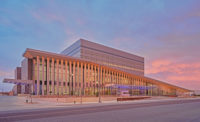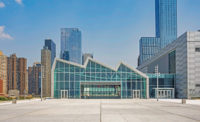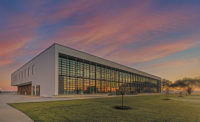The Star in Frisco: The Dallas Cowboys’ World Headquarters
Frisco, Texas
Best Project, Sports/Entertainment
Key Players
Owner: Dallas Cowboys Football Club; Lincoln Property Co.
Lead Design Firm: Gensler
General Contractor: Manhattan Construction Co.
Civil Engineer: Kimley-Horn and Associates Inc.
Structural Engineer: Walter P Moore
MEP: The Brandt Cos. LLC; Henderson Engineers Inc.
Owner’s Representative/Developer: Blue Star Land
Teams working on this one-of-a-kind project faced an aggressive schedule, a massive scope and the task of coordinating numerous stakeholders. The Star in Frisco is a $359-million, multi-use development located on 91 acres nearly 30 miles north of Dallas.
At the heart of the complex is the new Dallas Cowboys’ World Headquarters, The Ford Center, which spans 25 acres and includes a 1.7-million-sq-ft, state-of-the-art facility with a six-story office building; a 12,000-seat, indoor multipurpose events center and sports training facility; and two outdoor practice fields that provide facilities for the Dallas Cowboys, the city of Frisco and Frisco Independent School District.
The complex also includes the 300-room Omni Frisco Hotel and the Frisco Multi Event facility, along with an entertainment district of restaurants and shops, plus a medical center. The Baylor Scott & White Sports Therapy & Research at The Star will open in 2018.
A unique partnership among the Dallas Cowboys, the city of Frisco and Frisco ISD resulted in a public-private partnership for the mixed-use development. Not only is The Ford Center the only NFL training facility in the U.S. that is shared with the athletics program at a public high school, it’s also the most comprehensive NFL training facility in the U.S. It also houses the first indoor high school stadium in Texas.
“Our relationship with the Dallas Cowboys organization dates back many years. We did renovation work for them at Texas Stadium and built AT&T Stadium,” explains Mark Penny, senior vice president with Manhattan Construction, construction manager at-risk on the project. “When we heard they had partnered with the city of Frisco, we had a lot of interest in the project. The process moved quickly. I believe they first announced the project in May 2013, held a competitive solicitation for construction managers in October, and we were selected and completed negotiations by Thanksgiving. The first design meeting was in December. For a project this size, that is a faster-than-normal pace.”
Construction was slated to start in summer 2014, but when crews broke ground and began sitework, the team was only in the schematic design phases of the project. To maintain the schedule, phased construction packages were created, enabling construction to start without complete design or a gross maximum price.
“Being a public procurement process, we could not really get involved until the selection was final. Once [we were] on the team, which happened early in the schematic design, we engaged fully with our preconstruction services team,” Penny adds. “Everyone on the team, from the Cowboys and the city, to the designers and their partners, quickly became a unified team working together on the common goal of creating a special place for the community.”
Manhattan and lead design firm Gensler met multiple times a week in the early phases of the project to establish realistic document-deliverable dates.
“We built the project faster than they could design it,” notes Josh Sperling, general superintendent with The Brandt Cos., which performed mechanical, electrical and plumbing services on the job. “We were changing things as fast as we were installing them. [It was challenging to] stay on schedule while everything kept changing. We worked very hard with the design team to strategize a suitable outcome.”
Preconstruction was key to staying on schedule. “The project had a hard end date of being able to get the Frisco ISD into their spaces in time for the 2016 school year,” Penny says. “The shared parking garage not only serves the multi-use building and the office but also serves as the foundation for the hotel that was built later. Therefore, all the coordination had to be resolved as the work started on The Star.”
Additionally, the local construction market was heating up post-recession, and pricing was a challenge, Penny says. “Decisions had to be made quickly to obtain the most competitive pricing while keeping the work moving. Throughout preconstruction, regularly held meetings with all key players allowed resolution of questions quickly,” he explains.
The owner’s representative and project developer Blue Star Land was closely involved in all aspects of the design and the use of facilities, while careful consideration for the needs of both the city and Frisco ISD were taken into account when looking at possible changes.
Cost transparency was crucial since a portion of the project was publicly funded. Weekly cost and budget review meetings with the project ownership helped ensure that all enhancements and changes to the project scope fit within the GMP or warranted additional funding.
Prefabrication, overtime and efficient crew management were some of the ways the project team stayed on schedule.
An installation challenge that Brandt faced during MEP work was the support and hanging of the bowl supply ductwork and the smoke exhaust system in the indoor stadium. The roof’s structural steel was nearly 95 ft above field level, but the roof-truss system was not designed to support single-point loading or lifting of the ductwork and smoke exhaust fans into place. To fix the issue, the Brandt team devised a multipoint block-and-tackle system utilizing a 5,000-lb counterweight to lift the loads.
“This project also had the Cowboys’ headquarters building tied to the [stadium’s] HVAC system, which meant we had to have all the systems ready before the stadium was actually ready to feed the headquarters building with services for building turnover,” notes Sperling.
Although the project itself was in a central location, the size of the property and the equipment required coordinated deliveries across the site.
During construction in the multi-use space, the contractor hoisted large trusses, which required complex rigging plans, notes Penny. “Of course [this] was the critical path for the entire facility. Once these [trusses] were hung, work underneath them opened up and things moved faster,” he says.
On the Ford Center, the Manhattan team used innovative structural, lockable dowels, designed to be used at temporary movement joints in cast-in-place concrete structures in lieu of a traditional pour strip. These dowels allow initial shrinkage of the concrete and are then locked in position with a mechanical plate and epoxy resin.
Once locked, the dowels continue to transfer shear load but prevent any further movement of the concrete. Use of the system saved time compared with using traditional shoring systems below the recently placed deck. This improved site access and allowed construction of the follow-up trades to continue unobstructed beneath the elevated deck. That ultimately shaved more than a month off the schedule.
“The Star is a truly unique project on all fronts—from the public-private partnership between the city of Frisco, Frisco ISD, Frisco Economic Development and the Dallas Cowboys, along with Lincoln Property Co., to the types of projects encompassed under one roof. By combining a high school facility with a professional sports facility and adding corporate commercial office space, retail and an outdoor plaza, it took on a personality of its own,” Penny says. “Every aspect of what was built is a mixture of projects that has never been assembled like this in any other setting. This project is truly unique in that no one feature is common or normal in terms of everyday design and construction.”
Each section of the project had a different end date, and the development had to be open to the public before many parts were complete, Penny says. Teams had to ensure safety for both crews and the public, many of which were families and school-aged children, while construction on the multiple elements of The Star progressed. The multi-use facility finished in summer 2016, while work continued through this summer on many other parts of the development, Penny adds.
“Watching the public, especially the high school kids, walking into the stadium on opening day and seeing all the joy and happiness as they realized they are about to play or watch [a game] in the only enclosed, conditioned high school stadium in the world—that was truly a great achievement to walk away with,” Sperling says.
Related Article: Diverse Projects Named Region’s Best









Post a comment to this article
Report Abusive Comment